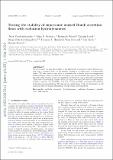Testing the stability of supersonic ionized Bondi accretion flows with radiation hydrodynamics
Abstract
We investigate the general stability of 1D spherically symmetric ionized Bondi accretion on to a massive object in the specific context of accretion on to a young stellar object. We first derive a new analytic expression for a steady-state two-temperature solution that predicts the existence of compact and hypercompact H ii regions. We then show that this solution is only marginally stable if ionization is treated self-consistently. This leads to a recurring collapse of the H ii region over time. We derive a semi-analytic model to explain this instability, and test it using spatially converged 1D radiation hydrodynamical simulations. We discuss the implications of the 1D instability on 3D radiation hydrodynamics simulations of supersonic accreting flows.
Citation
Vandenbroucke , B , Sartorio , N S , Wood , K , Lund , K , Falceta-gonçalves , D , Haworth , T J , Bonnell , I , Keto , E & Tootill , D 2019 , ' Testing the stability of supersonic ionized Bondi accretion flows with radiation hydrodynamics ' , Monthly Notices of the Royal Astronomical Society , vol. 485 , no. 3 , pp. 3771-3782 . https://doi.org/10.1093/mnras/stz357
Publication
Monthly Notices of the Royal Astronomical Society
Status
Peer reviewed
ISSN
0035-8711Type
Journal article
Description
BV and KW acknowledge support from STFC grant ST/M001296/1. NSS would like to thank CAPES for graduate research funding. KL acknowledges support from the Carnegie Trust. DFG thanks the Brazilian agencies FAPESP (no. 2013/10559-3) and CNPq (no. 311128/2017-3) for financial support. TJH is funded by an Imperial College London Junior Research Fellowship.Collections
Items in the St Andrews Research Repository are protected by copyright, with all rights reserved, unless otherwise indicated.

